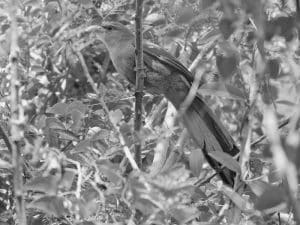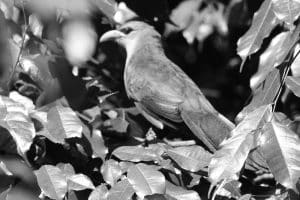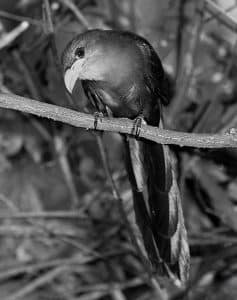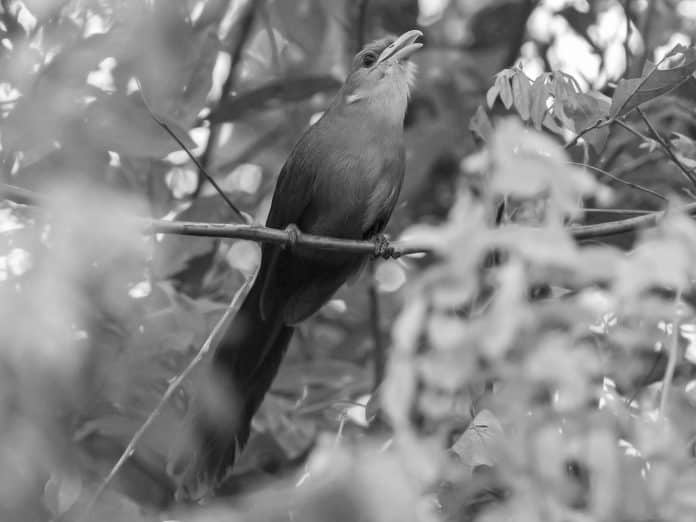Introduction to the Green Malkoha
Welcome to Tanzania, a birdwatcher’s paradise, where you can find an array of unique and captivating bird species. One such fascinating bird that graces the Tanzanian skies is the Green Malkoha. With its vibrant plumage and intriguing habits, the Green Malkoha in Tanzania is a delightful sight for any nature enthusiast. In this article, we will explore the habitat, physical characteristics, feeding habits, breeding behavior, conservation status, and the best places to spot the Green Malkoha in Tanzania. So, grab your binoculars, and let’s delve into the world of this magnificent bird.
Habitat and Distribution of the Green Malkoha in Tanzania

The Green Malkoha is predominantly found in the tropical forests and woodlands of Tanzania. Its habitat extends across various regions, including the Eastern Arc Mountains, the coastal forests of the Indian Ocean, and the southeastern parts of the country. These areas provide the perfect combination of dense vegetation and abundant food sources, making them ideal for the Green Malkoha’s survival.
Within Tanzania, the Green Malkoha can be spotted in specific national parks and reserves, such as the Udzungwa Mountains National Park, Saadani National Park, and the Selous Game Reserve. These protected areas offer a haven for the bird, ensuring its continued existence amidst the ever-changing environmental landscape.
Physical Characteristics of the Green Malkoha
The Green Malkoha is a medium-sized bird, measuring around 30 centimeters in length. It possesses a distinct appearance, with its long tail and vibrant green plumage. The bird’s head is adorned with a black mask that extends from the eyes to the beak, giving it a mysterious and captivating allure.
The Green Malkoha has a strong, curved beak, which it uses to forage for insects, fruits, and small reptiles. Its legs are relatively short, yet sturdy, allowing it to navigate through the dense vegetation of its habitat with ease. With its graceful flight and unique physical features, the Green Malkoha stands out among its avian counterparts.
Diet and Feeding Habits of the Green Malkoha
The Green Malkoha is primarily an insectivorous bird, feeding on a variety of insects, including grasshoppers, crickets, and beetles. It also supplements its diet with fruits, berries, and small reptiles. With its keen eyesight and agile movements, the Green Malkoha skillfully hunts for prey in the dense foliage of its habitat.
Unlike some other bird species, the Green Malkoha is not known for its vocalization. It relies on stealth and camouflage to approach its prey without detection. Once it spots a potential meal, it swiftly pounces, seizing the unsuspecting insect or lizard with its sharp beak. This hunting technique, combined with its diverse diet, ensures the Green Malkoha’s survival in its natural habitat.
Breeding Behavior and Nesting of the Green Malkoha

The breeding season of the Green Malkoha typically occurs during the rainy season, which provides an abundance of food resources for the growing chicks. During courtship, the male Green Malkoha showcases its vibrant plumage and engages in elaborate displays to attract a mate. Once a pair is formed, they work together to build a nest.
The Green Malkoha constructs its nest using twigs, leaves, and other plant materials. The nest is usually located in the dense vegetation, providing protection and camouflage from potential predators. The female lays a clutch of two to three eggs, which are incubated by both parents. After an incubation period of approximately two weeks, the chicks hatch and are cared for by their devoted parents. This cooperative breeding behavior ensures the survival and growth of the Green Malkoha population.
Conservation Status of the Green Malkoha in Tanzania
The Green Malkoha is classified as a species of least concern on the IUCN Red List. However, despite this relatively stable status, the bird faces certain threats that necessitate conservation efforts. Habitat loss due to deforestation, agricultural expansion, and human encroachment poses a significant risk to the Green Malkoha’s survival.
To protect this beautiful bird, various conservation organizations and Tanzanian authorities have implemented measures to preserve its habitat and raise awareness about its importance. These initiatives include the establishment of protected areas, habitat restoration projects, and educational programs for local communities. By supporting these conservation efforts, we can contribute to the long-term survival of the Green Malkoha and the preservation of Tanzania’s rich biodiversity.
Best Places to Spot the Green Malkoha in Tanzania

To catch a glimpse of the stunning Green Malkoha, head to the Udzungwa Mountains National Park. This park offers a diverse range of habitats, including montane forests and grasslands, where the bird is commonly found. Explore the park’s various trails and keep your eyes peeled for the flashes of green amidst the foliage.
Another excellent location for birdwatching the Green Malkoha is the Saadani National Park. This coastal park is a unique blend of marine and terrestrial ecosystems, providing a habitat that supports a wide array of bird species. The Green Malkoha can often be seen perched on branches or gliding through the air, showcasing its distinctive beauty.
For a truly immersive birdwatching experience, visit the Selous Game Reserve. This vast wilderness is a UNESCO World Heritage Site and offers unparalleled opportunities to observe wildlife, including the Green Malkoha. Embark on a safari adventure and witness the bird’s natural behavior in its pristine habitat.
Tips for Birdwatching the Green Malkoha in Tanzania
When embarking on your birdwatching journey in Tanzania, here are some tips to enhance your chances of spotting the Green Malkoha:
- Start early: The Green Malkoha is most active during the early morning hours, so plan your birdwatching expeditions accordingly.
- Bring binoculars: Investing in a good pair of binoculars will allow you to observe the Green Malkoha’s intricate features and behaviors from a distance.
- Dress appropriately: Wear muted and comfortable clothing to blend in with the surroundings and avoid disturbing the birds.
- Be patient and observant: The Green Malkoha can be elusive at times, so take your time to scan the trees and listen for any telltale calls.
- Respect their habitat: When birdwatching, ensure that you maintain a safe distance from the birds and refrain from disturbing their nests or natural environment.
By following these tips, you can maximize your chances of encountering the Green Malkoha and create unforgettable memories of your birdwatching adventures in Tanzania.
Other Bird Species Found in the Same Habitat as the Green Malkoha
The habitat of the Green Malkoha in Tanzania is not only home to this captivating bird but also hosts a diverse range of other avian species. Some of the notable bird species found in the same habitat as the Green Malkoha include:
- African Crowned Eagle: This impressive raptor is known for its powerful build and striking plumage. Keep an eye on the treetops to catch a glimpse of this majestic bird.
- Fischer’s Turaco: With its vibrant green and red plumage, the Fischer’s Turaco is a true gem of the Tanzanian forests. Look for its distinctive call and follow it to spot this beautiful species.
- Olive Sunbird: This small but vibrant bird is a master of acrobatic flight. Watch as it hovers near flowers, sipping nectar with its slender beak.
- Hartlaub’s Turaco: Another turaco species found in Tanzania, the Hartlaub’s Turaco boasts a colorful combination of green, red, and yellow feathers. Keep your eyes peeled for its striking appearance.
By exploring the habitat of the Green Malkoha, you not only increase your chances of encountering this unique bird but also open yourself up to a world of avian wonders.
Conclusion: The Beauty and Importance of the Green Malkoha in Tanzania
The Green Malkoha, with its vibrant plumage, intriguing habits, and unique characteristics, is a true delight for birdwatchers in Tanzania. As we have explored in this article, this captivating bird thrives in the country’s tropical forests and woodlands, relying on a diverse diet and exhibiting fascinating breeding behavior.
While the Green Malkoha’s conservation status currently stands at least concern, it is crucial to remember the threats it faces due to habitat loss. By visiting the best spots to spot the Green Malkoha, supporting conservation efforts, and respecting the bird’s natural habitat, we can play a part in ensuring its continued existence for future generations to appreciate.
So, as you embark on your birdwatching adventures in Tanzania, keep your eyes peeled and your senses attuned to the unique beauty of the Green Malkoha. Let the vibrant green plumage guide you through the lush forests, and may the enchanting melodies of the Tanzanian birdlife fill your heart with joy and appreciation for the wonders of nature.

































